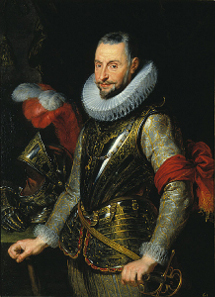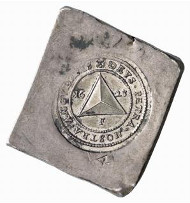translated by Annika Backe
Early in 1621, two armies with nothing to do stood in the middle of Southern Germany. Their commanders had to find them a new task, which did not pose a problem at all in that century of war. In the Netherlands, war was raging between the Spanish soldiers and the troops of the United Provinces.
Workshop of Peter Paul Rubens, Marquis Ambrogio Spinola, around 1630.
The Catholics on the inside track
On 9 April 1621, the ceasefire between Spain and the United Provinces expired. Already in the summer of that year, a Spanish army, led by Ambrogio Spinola, was heading towards the Netherlands. The first goal was to bring the commanding fortress of Jülich under Spanish control.
Jülich. Frederik Pithan, Commander of Jülich, 1614-1622. Uniface coin of 20 stüver struck during the siege, 1621. Auction Künker 122 (2007), 4327.
This fortress was being held by Dutch troops under the command of Fredrik Pithan since the first treaty on the division between Brandenburg and Palatinate-Neuburg. The plan was that 7,000 foot soldiers and 700 cavalrymen, led by Duke Henry von dem Berg, would take the fortress.
Jusepe Leonardo, The Surrender of Jülich, 1635.
The siege began on 5 September 1621, the formal surrender was declared on 3 February 1622. No assault had actually been launched, but the shortage of provisions had led Commander Frederik Pithan to surrender, which the United Provinces consequently repaid with livelong fortress detention.
Afterwards, the experienced Spanish mercenaries reached the gates of Bergen op Zoom. It was clear to see that this city, too, would have been forced to surrender soon. It was thanks to the assistance of Christian of Halberstadt and Mansfeld, however, that the Dutch managed to relieve Bergen op Zoom.
The 1622 Siege of Heidelberg in a contemporary pamphlet, 1622.
What remained of the Protestant troops in the Palatinate, though, knew well that there was no great chance of getting any more help in the foreseeable future. After an 11 week-siege, the occupying troops at Heidelberg laid down their arms on 19 September 1622, and the troops besieging Mannheim did the same on 5 November 1622.
Frankenthal. Uniface klippe of 4 gulden 1623. Auction Künker 116 (2006), 4525.
The English were the only ones who carried on defending their Veste at Frankenthal.
Bavaria. Maximilian I, 1598-1651. Gold gnadenpfennig n. y. (1623) on being invested with the electoral dignity. Auction Künker 78 (2002), 4586. – Archival records inform us that Maximilian had the Munich gold smith Christoph Ulrich Eberl produce 60 specimens of a gnadenpfennig that were given away as a present on the occasion of Maximilian becoming Elector in Regensburg. Similar to modern orders, the recipients wore these gnadenpfennige attached to their clothes, as a visible sign of the Elector’s favor.
A Habsburg victory became more and more likely. There was not a single Protestant army fighting imperial troops on the territory of the Empire left. Ferdinand thought the time was right to call in a general assembly of electors, to take place at Regensburg on 10 January 1623, and invested Maximilian, Duke of Bavaria, with the electoral dignity, which ostracized Fredrick V had forfeited. With this promise that he had given Maximilian prior to his help against the Bohemian rebels, Frederick honored a huge debt that had piled up due to the Bavarian army being in the fields for years without interruption. That debt is said to have amounted to a sum ranging between 16 and 18 million gulden. Maximilian was not only invested with the electoral dignity but, as pledge, he was also granted the right to administer the revenues from Upper Austria as well as full possession of the Upper Palatine.
Bavaria. Maximilian I. Reichsthaler, 1625. Auction Künker 249 (2014), 823.
Although Frederick attached the electoral dignity to Maximilian, thanks to which Frederick’s heirs could have claimed the electoral dignity for themselves after Maximilian’s death, his regulation met with strong resistance. The electors accused him of clearly exceeding his authority. No emperor had ever unseated an elector – without checking with the electoral college first (!) – and instituted another one. That might have been considered a precedent by the emperor, giving him the right to choose his successor all by himself in the future.
Jacques Callot, The Great Miseries of War 11: The Hanging, 1632.
The great miseries of war
George Frederick of Baden-Durlach retreated from war when he witnessed first-hand what the soldiers experienced during battle. Frederick V of the Palatine had discharged the troops of Mansfeld and Christian of Halberstadt because he could not bear the atrocities of a fouraging army anymore. Ferdinand II likewise traveled through a devastated country in the spring of 1623.
Sebastian Vrancx, Marauding Soldiers, 1647.
Three armies had marched through Bohemia, turning the green pastures into a wasteland. To Ferdinand, that was merely a judgement from above. He was not interested in reconciling with the Bohemian subjects but in punishing the rebels. Having arrived in Prague, he ordered all insurgents known by name to be ousted. Those burdened with less guilt and sympathizers were stripped of “just” a fifth of their possessions.
The seized possessions did not become part of the Habsburg estate as royal assets. Ferdinand was in dire need of money, and so he wasted no time but sold the confiscated property at once. Yet who had any money left, in Bohemia in 1623? Well, just a few Catholics who were loyal to the emperor. They used coins, whose value had decreased by more than two third during the kipper and wiper period, to buy the seized goods at the old prices. That was a highly lucrative business! In the long run, however, this led to the ruin of the Bohemian middle classes and the rise of a group of Catholic tycoons.
Equestrian portrait of Albrecht of Wallenstein. Copperplate print, 1625/1628.
One of these was the military commander of Prague, Albrecht of Wallenstein, a rich man already before the rebels were being ousted. In 1619, for example, he was in the position to lend Ferdinand 40,000 gulden, and in 1620, it was even 160,000 gulden. He invested his capital and made quite a profit by acquiring confiscated lands, which allowed him to provide the emperor with an incredible loan of 500,000 gulden in 1623. Ferdinand in turn made him Duke of Friedland and arranged a marriage with the daughter of one of his most loyal advisers.
Albrecht of Wallenstein seemed to be a highly useful tool for the emperor in his desire to rule over the new Bohemia. Born into gentry, lacking the pride in a long and honorable past, all that he got he owed to the emperor and, accordingly, was compelled to be loyal. At least, that might have been Ferdinand’s thinking in 1623.
In the next episode you will read about how Denmark came to intervene in the war – with dramatic repercussions.
A report on the wheelings and dealings of the Bohemian coin consortium is available with our podcasts under Jicin, 1627.
All episodes of this series can be accessed here.















